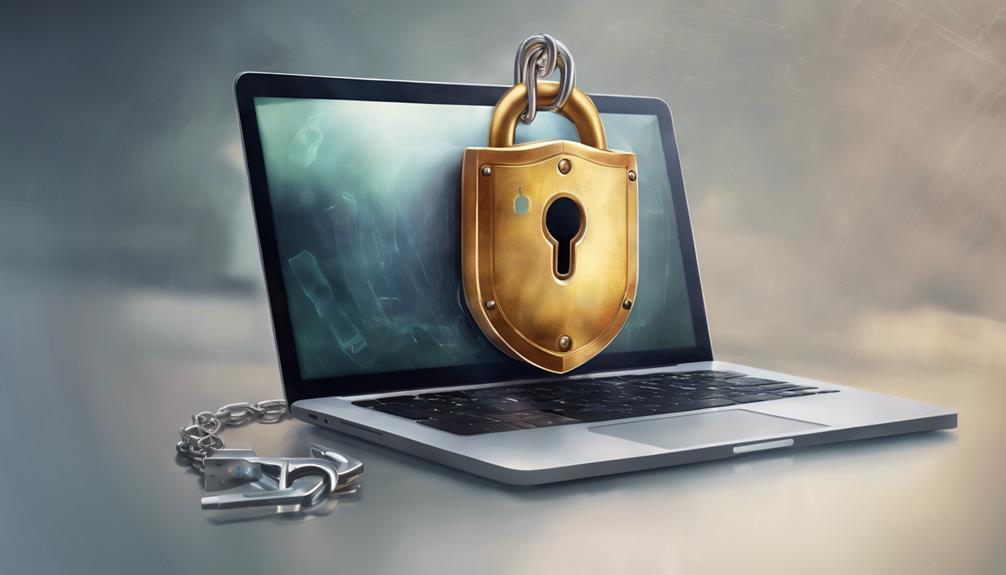Mac users can enhance their security against hackers by utilizing a combination of measures. Important steps include enabling features like Gatekeeper and System Integrity Protection, utilizing strong passwords and Multi-Factor Authentication, downloading apps from trusted sources like the Mac App Store, and ensuring regular updates. These precautions help mitigate risks of malware, adware, ransomware, trojans, and social engineering attempts. Additionally, maintaining backups, utilizing encryption like FileVault, and staying informed about security best practices are crucial. By implementing these strategies, Mac users can greatly boost the security of their systems and protect against potential cyber threats.
Key Takeaways
- Regularly update macOS and applications for security.
- Enable Firewall and Gatekeeper for added protection.
- Use strong, unique passwords and Multi-Factor Authentication.
- Avoid suspicious downloads and phishing attempts.
- Backup data regularly to prevent data loss from attacks.
Mac Security Overview
Mac security on Apple's operating system has traditionally been regarded as robust and reliable. Apple's dedication to privacy and security has made Macs a preferred choice for users seeking to protect sensitive information.
Despite facing fewer cyber attacks than PCs in the past due to their lower market share, Mac-specific malware incidents are on the rise. To enhance protection, Apple has integrated security features like Gatekeeper, XProtect, and iCloud Keychain into its operating system. These tools help safeguard Mac users from various threats such as malware, adware, ransomware, trojans, and social engineering attacks.
Users are advised to remain vigilant and employ additional security measures like two-factor authentication and Rapid Security Response to fortify their Macs against potential breaches.
As the threat landscape evolves, staying proactive and informed about the latest security practices is essential in ensuring the ongoing security of Mac devices.
Types of Mac Threats

Mac users face a myriad of threats to their system security, ranging from common malware and adware to sophisticated phishing schemes and targeted attacks.
With the rise of Mac-specific malware incidents, it is essential for users to be vigilant and proactive in safeguarding their devices.
Understanding the types of threats, such as phishing attempts and malware targeting Mac systems, is vital for implementing effective security measures to protect sensitive data and information.
Common Mac Threats
Common threats facing macOS systems include malware, adware, ransomware, trojans, and social engineering attacks. Mac users are increasingly at risk from adware and potentially unwanted programs that can compromise their system's security. Malicious websites and cryptojacking schemes are also prevalent threats targeting Mac users. Malware, in particular, poses a significant risk to both performance and security on Mac devices. As the popularity of Macs continues to grow, cybercriminals are developing more sophisticated Mac-specific malware to exploit vulnerabilities in these systems.
| Common Mac Threats | Description |
|---|---|
| Malware | Software designed to disrupt, damage, or gain unauthorized access to a computer system. |
| Adware | Unwanted software that displays advertising to the user. |
| Ransomware | Malware that encrypts a user's files and demands payment for their release. |
| Trojans | Malicious programs disguised as legitimate software to trick users into installing them. |
| Social Engineering | Manipulative techniques used to deceive users into divulging confidential information or installing malicious software. |
Phishing on Mac
Phishing poses a significant threat to the security of macOS systems, utilizing deceptive tactics to exploit user trust and gather sensitive information. Mac users are vulnerable to phishing attacks that involve deceptive emails or messages designed to trick individuals into revealing confidential data such as passwords.
These scams can manifest through fake websites, emails, or messages that impersonate legitimate entities, potentially leading to identity theft, financial loss, or unauthorized access to personal information. Common tactics used in phishing on Mac include creating fake login pages, sending urgent requests for personal data, and offering fraudulent deals to lure unsuspecting individuals.
To safeguard against falling victim to phishing on Mac, users should always verify the authenticity of senders, refrain from clicking on suspicious links, and promptly report any phishing attempts encountered. By staying vigilant and implementing these precautions, Mac users can better protect themselves from the risks posed by phishing attacks.
Malware Targeting Mac
Various types of malicious software, including adware, potentially unwanted programs, ransomware, trojans, and social engineering attacks, pose significant threats to the security of Apple devices. Mac users are increasingly vulnerable to attacks from malicious websites and cryptojacking schemes, which can compromise system performance and data security.
Cybercriminals are actively developing more sophisticated Mac-specific malware to target unsuspecting users. To combat these threats, staying informed about the latest security updates is essential. Regularly updating your Mac's operating system and applications can help protect against known vulnerabilities that malware often exploits.
Additionally, exercising caution when downloading software from untrusted sources, being wary of suspicious emails or messages, and avoiding clicking on unknown links can help mitigate the risk of falling victim to malware attacks. Vigilance and proactive security measures are necessary to safeguarding your Mac from the evolving landscape of cybersecurity threats.
Built-in Security Features

Macs come equipped with essential built-in security features, such as System Integrity Protection and Gatekeeper.
System Integrity Protection safeguards critical system files and directories from being modified, ensuring the integrity of the operating system.
Gatekeeper acts as a gatekeeper, verifying the authenticity of applications to prevent potentially harmful software from infiltrating the system.
System Integrity Protection
System Integrity Protection, an integral component of macOS, functions as a vital built-in security feature safeguarding system files and processes from unauthorized alterations. By restricting the root user's access to critical system files, SIP plays a significant role in enhancing the security of macOS.
This protection is essential in preventing unauthorized modifications that could compromise the integrity of the operating system and the confidentiality of personal information stored on the device. SIP serves as a barrier against potential vulnerabilities, reducing the risk of malware attacks and unauthorized software installations that could harm the system.
Enabling SIP is highly recommended to uphold the stability and security of macOS, particularly in environments where safeguarding system integrity is paramount. Essentially, System Integrity Protection acts as a fundamental defense mechanism, fortifying the Mac system against malicious activities and ensuring the protection of sensitive data.
Gatekeeper Feature
The Gatekeeper feature in macOS serves as an essential security measure designed to verify the authenticity of apps sourced from external locations, thereby mitigating the risk of malware infiltration. This built-in security feature acts as a safeguard by checking the digital signature of applications, ensuring they originate from identified developers rather than untrusted sources.
Gatekeeper offers users three distinct security settings: allowing apps exclusively from the Mac App Store, permitting downloads from the Mac App Store and identified developers, or allowing installations from anywhere. By default, Gatekeeper is set to the second option, bolstering protection against potentially harmful software while still offering some flexibility in app installations.
Users have the ability to adjust these settings in System Preferences, providing a balance between security and the freedom to install applications from various sources. Ultimately, Gatekeeper plays an important role in fortifying the security of macOS systems against malicious attacks originating from unverified software sources.
Enhancing Mac Security

Improving the security measures on a Mac system can greatly bolster its defenses against potential cyber threats. One effective method to enhance Mac security is by implementing Multi-Factor Authentication (MFA). MFA adds an extra layer of protection by requiring users to provide multiple forms of verification before accessing their devices or accounts. This greatly reduces the risk of unauthorized access, even if passwords are compromised.
In addition to MFA, regular software updates play an important role in strengthening Mac security. Apple continuously releases patches to address vulnerabilities and enhance the system's overall resilience against emerging threats.
Features like Touch ID, Secure Enclave, and Lockdown Mode further fortify the device's security posture, making it harder for malicious actors to compromise sensitive information. Despite Macs historically facing fewer attacks than Windows PCs, it is essential to remain vigilant against malware, adware, ransomware, and social engineering tactics that could still pose a threat to Mac users.
Importance of Strong Passwords

How important is using a strong password to safeguard your Mac from hackers?
Utilizing a robust password is an essential step in protecting your Mac from unauthorized access. A strong password should ideally be a minimum of 12 characters long, comprising a combination of letters, numbers, and special characters. It is vital to avoid incorporating easily guessable information such as birthdays or common words into your password, as these can be vulnerable to hacking attempts.
Furthermore, implementing Multi-Factor Authentication (MFA) adds an extra layer of security to your Mac. MFA requires users to provide two or more forms of verification before accessing their accounts, making it considerably harder for hackers to breach your system.
Regularly updating passwords and refraining from reusing them across different platforms can also bolster your Mac's security measures. Considering the use of a password manager can aid in generating and securely storing complex passwords, further strengthening your defense against potential cyber threats.
Secure App Downloads

Utilizing secure app downloads is crucial for maintaining the integrity and safety of your Mac system. When downloading apps, consider the following:
- Use the Mac App Store: The Mac App Store is a safer option as Apple reviews apps for security before listing them, reducing the risk of malware or security breaches.
- Avoid third-party websites: To minimize security risks, refrain from downloading apps from unverified third-party websites where malicious software may be present.
- Enable Gatekeeper: Activate Gatekeeper on your Mac to guarantee that only trusted apps from identified developers can be installed, enhancing the security of your system.
Regular Security Updates

Regularly updating your Mac's security features is vital for safeguarding your system against potential cyber threats and vulnerabilities. Apple provides regular security updates that are designed to prevent unauthorized access to your device. These updates include patches for security holes and fixes for potential exploits that hackers could use to compromise your system. By keeping your macOS and applications up to date, you are taking a proactive step in maintaining a secure environment for your digital activities.
Hackers often target devices with outdated software, as they are more vulnerable to attacks. By enabling automatic updates on your Mac, you make sure that you receive the latest security patches promptly, reducing the window of opportunity for potential cyber threats.
It is essential to stay vigilant and prioritize regular security updates as part of your overall cybersecurity strategy to protect your data and privacy from unauthorized access.
Data Backup and Protection

To further strengthen your Mac's security measures, it is essential to focus on data backup and protection strategies. Safeguarding your data is vital in ensuring complete security against potential hacking threats.
Here are essential steps to enhance your Mac's data backup and protection:
- Regular Backups: Regularly back up your data to an external drive or cloud storage to protect against data loss from hacking.
- FileVault Encryption: Enable FileVault on your Mac to encrypt your data and prevent unauthorized access, adding an extra layer of security.
- Time Machine Utilization: Use Time Machine to create automatic backups of your entire system, including files, applications, and settings, ensuring thorough protection against data loss.
Frequently Asked Questions
Can I Tell if My Macbook Has Been Hacked?
To determine if your Macbook has been hacked, monitor for unexplained settings changes, unusual activity, unfamiliar programs, missing files, or suspicious processes. Utilize antivirus software, conduct malware scans, and seek cybersecurity professionals if needed for assistance.
How Do I Make Sure My Mac Is Secure?
Strengthen Mac security by fortifying defenses with Firewall, FileVault, and iCloud Keychain. Update software regularly, use unique passwords with 2FA, avoid risky networks and links, and monitor for suspicious activity. Vigilance is key.
How to Keep Your Macbook Safe From Hackers?
To keep your Macbook safe from hackers, implement Two Factor Authentication, update your macOS and applications regularly, use strong, unique passwords, avoid unsecured Wi-Fi networks, and monitor for unusual activity. These practices enhance overall security.
How to Check if Your Mac Is Being Monitored?
To guarantee your Mac's security, carefully scrutinize background processes, detect unauthorized software, monitor system performance, review network settings, and seek cybersecurity expertise if monitoring suspicions arise. Vigilance is key in safeguarding against potential breaches.
Conclusion
To sum up, Mac users can enhance their security by utilizing built-in features, maintaining strong passwords, downloading apps from secure sources, regularly updating their systems, and backing up important data.
By following these practices, individuals can better protect their devices from potential threats and hackers. Remember, prevention is key in maintaining the security of your Mac.









